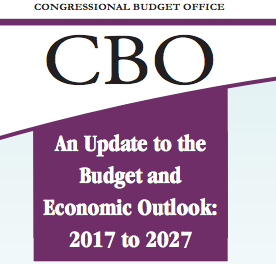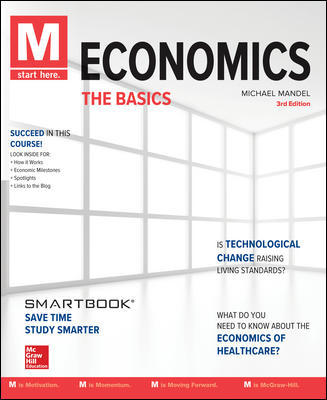February 2017 (updated March 2017):
In the coming months, Congress and President Trump will be wrestling with the federal budget for the 2018 fiscal year, which starts on October 1, 2017 and ends on September 30, 2018. One big decision they will face is whether to reduce or expand the federal budget deficit. The federal budget deficit is the difference between the amount that the government collects through taxes, and the amount that it spends, while the debt is the total amount it owes, accumulated over time. During his February 28, 2017 address to Congress, President Trump proposed policies that would expand the budget deficit by cutting corporate and personal income taxes, maintaining entitlement spending, and investing an additional $1 trillion in infrastructure, alongside new investments in women’s health and construction of a multibillion dollar wall along the U.S.-Mexico border. Then on March 16, Trump followed up with a budget proposal that included a $54 billion increase in military expenditures, combined with matching and deep cuts in spending for many government agencies, including the Environmental Protection Agency and the State Department.
Of course, Trump’s budget proposal is just that—a proposal. It still has to be approved by Congress. Many members of Congress, both Democrats and Republicans, think the cuts go too deep. Others think that the cuts are not deep enough. For example, many lawmakers in the Republican-controlled Congress continue to push for dramatic cuts in Medicare, Medicaid and Social Security.
A March 2017 National Association for Business Economics (NABE) survey of 285 economists found that a large majority (78 percent) expect the Trump administration to increase the deficit as a percentage of GDP over time. How will this affect the economy?
Writing in early 20th century, John Maynard Keynes theorized that governments can stimulate economic growth during downturns by increasing spending and cutting taxes—two policies that boost aggregate demand and increase GDP. In 1931 his student, Richard Kahn, supported this idea by pointing out that, when a recession creates under-utilized resources, such injections can potentially have a multiplier effect, increasing GDP by more than the amount spent.
Take, for instance, the example of the government expanding a military base in the United States. During the construction process, it hires a firm to design the new buildings on the base, another firm to build the new structures, pays laborers’ salaries, and purchases materials like concrete and steel. The salaries and profits resulting from this spending end up in the hands of individuals and firms, who in turn can choose to spend the money on more goods and services, increasing aggregate demand more than the original amount spent and further boosting GDP. The extent of this multiplier effect is determined by how much these individuals and firms choose to spend and how much they choose to save, and by how much excess capacity the economy has
Since Kahn’s theory was first published, economists have vigorously debated not only whether such multipliers exist, but also how they might vary due to the type of government stimulus or underlying economic conditions. Conservative Harvard economist Robert Barro has argued that, in the long-run, multipliers tend to be close to zero, because every dollar spent by the government will eventually result in one less dollar spent elsewhere in the economy. Following this thinking, some economists have even argued that fiscal stimulus can lead to “crowding out.” If the government needs to borrow significant amounts to fund a stimulus, interest rate increases might cause a decrease in spending, leading to a negative multiplier (a decrease in GDP, despite the government’s expansionary intentions).
Still, many economists believe multipliers are real and play a substantial role in fiscal policy. For instance, a distinguished group of economists led by Miguel Almunia estimated that the initial multiplier of increased defense spending during the 1930s was a whopping 2.5! This would mean that every dollar of government spending led to 2.5 dollars in GDP growth, making it a sound policy not only because it equipped the military for World War II, but also because it helped spark the rapid growth than ended the Great Depression.
Stimulus packages have taken a variety of forms throughout American history. President Ronald Reagan, a Republican, stimulated the economy following an early 1980s recession primarily via tax cuts and a 40 percent annual increase in military expenditure from 1980-1987, while the Democratic President Barack Obama’s 2009 $787 billion American Recovery and Reinvestment Act stimulated the economy by cutting taxes, spending on infrastructure, and offering tax credits for education and energy efficiency. Which of these proposals would have the greatest multiplier effect, stimulating growth most per every dollar spent?
This is a difficult question to answer, as data on the size of various multipliers are notoriously hard to come by. Economists cannot run a controlled experiment on an entire economy and many statistics about underlying economic conditions are tough to estimate. For this reason, in its widely-cited analysis of the Obama-era American Recovery and Reinvestment Act, the CBO offered ranges for the effects of different economic programs. As you will see in the accompanying chart, federal government purchases of goods and services, as well as infrastructure spending on the state and local level were thought to have the highest potential multipliers, while tax cuts for high-income individuals likely had the smallest estimated effect. This is likely because high-income individuals that receive additional money are less likely to spend it than low-income individuals and aggregate demand is largely a measure of spending. The CBO’s analysis did not include estimated multipliers for increased military spending, as this was not a significant part of the 2009 stimulus.
But even if the CBO’s data are reliable, its insights are not necessarily applicable in the present day. The economy of 2017 is quite different from the economy of 2009, which was in the midst of a major recession, and we cannot assume that the same policies will prove effective. Economists have suggested a variety of appropriate stimulus programs for the current economy oftentimes geared towards addressing the 2009 stimulus’ failings. For instance, in 2014, after the Great Recession had ended, conservative economist Martin Feldstein wrote that a five-year $1 trillion government investment in infrastructure, coupled with a reduction in US government debt would provide a tremendous boost to the economy. Former Federal Reserve Chair Ben Bernanke, who identifies as an independent, alternatively suggested earlier this year that the economy is actually no longer in dire need of major fiscal stimulus and instead should focus on a more measured program that boosts productivity without increasing inflation.
However, both Bernanke and Feldstein are quick to note that no matter how much evidence they offer their proposals oftentimes fall on deaf ears. Even if economists can somehow agree on the right stimulus package with a high multiplier, they need to overcome strong Republican opposition to increased spending and strong Democratic opposition to substantial tax cuts. Fiscal policy is not simply a technocratic tool determined by experts—it is also profoundly political.
By Adam Lerner
Note: This textbook-based blog is explicitly non-political. We analyze current events for the beginning economics students without imposing our own views on the topic.
Key Terms
Budget deficit:The excess of the federal government’s spending over its revenues.
Multiplier effect:The short-term boost in economic activity that flows from the government’s spending increase (or tax cut).
Crowding out:A decline in private investment that results from an increase in government borrowing that pushes up interest rates.
Review Questions
Additional Readings
Carew, Diana and Mandel, Michael. “Infrastructure Investment and Economic Growth: Surveying New Post-Crisis Evidence,” Progressive Policy Institute Policy Memo March 2014.
Cassidy, John. “The Demand Doctor,” The New Yorker October 10, 2011.http://www.newyorker.com/magazine/2011/10/10/the-demand-doctor
Kopan, Tal. “Here’s what Trump’s budget proposes to cut” CNN, March 16, 2017 http://www.cnn.com/2017/03/16/politics/trump-budget-cuts/
Matthews, Dylan. “Did the Stimulus Work? A review of the nine best studies on the subject,” The Washington Post, August 16, 2011.
“Much Ado About Multipliers,” The Economist September 24, 2009. http://www.economist.com/node/14505361



